




Every year, a thick layer of smoke and haze blanket most of Thailand, Myanmar and Laos between January and April. This smoke is full of toxic pollutants, most notably PM2.5 — particles so small that they can’t be captured in the lungs, but pass right through the lungs’ walls into the bloodstream, where they cause blood clots, heart attacks, strokes, and cancer.
It’s a terrible problem that affects millions of people every year.
In 2019, PM2.5 was estimated to have caused 32,200 premature deaths in Thailand alone, and another 24,200 in Myanmar. In the same year, PM2.5 cost the population of Thailand 888,400 years of life and productivity due to ill-health, disability or early death.1
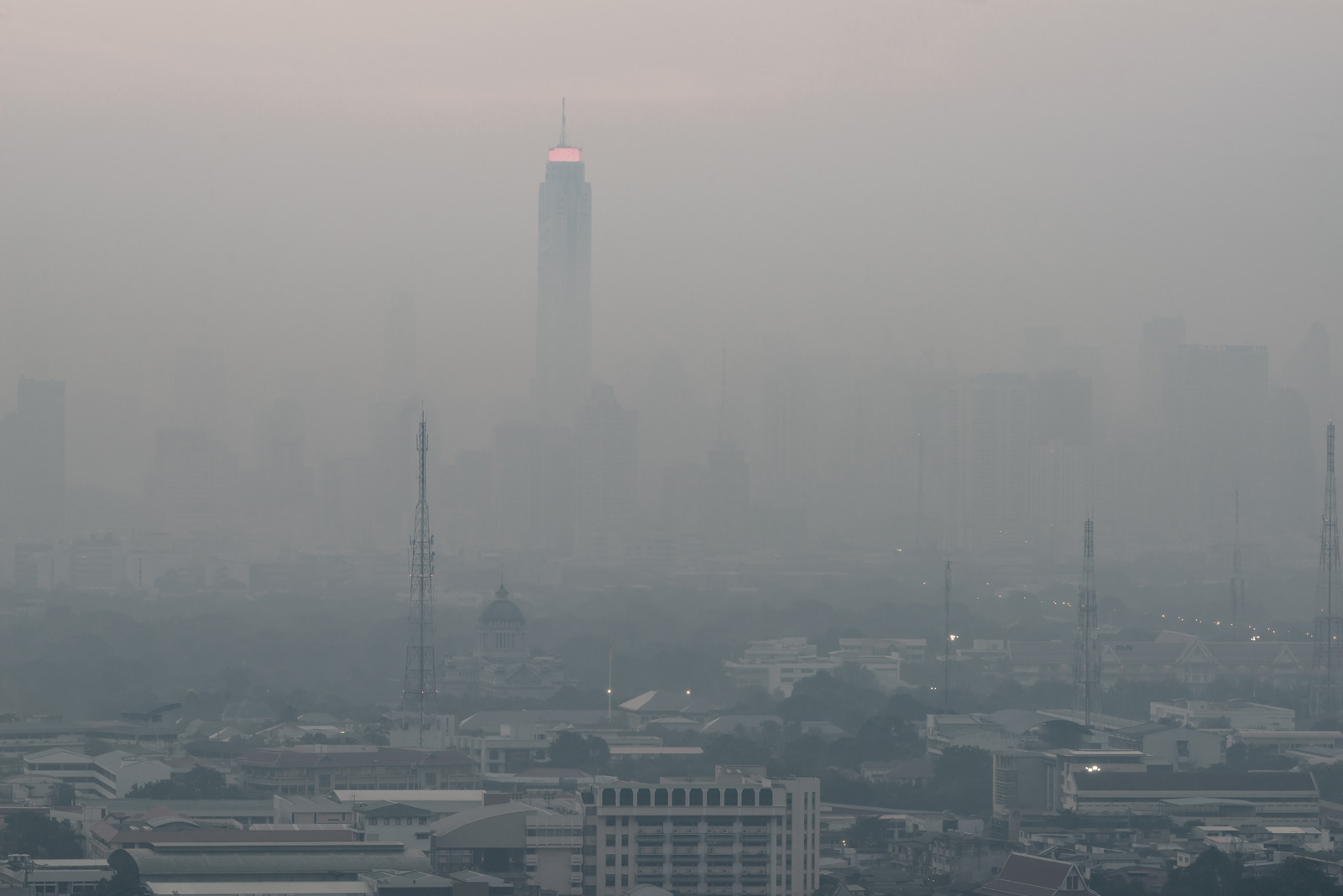
Besides the tragic loss of human life, PM2.5 causes other social, economic, and environmental costs. Airports close. Tourists don’t come. Schools shut, stopping children’s education. In Thailand, the economic cost directly attributed to air pollution has quadrupled from ฿211 billion in 1990 to ฿871 billion in 20132. The burning releases not just PM2.5, but vast amounts of GHGs that warm the climate and impair Thailand’s progress toward its international commitment to reduce carbon emissions. Huge quantities of black carbon are also emitted – a fine soot that’s carried through the atmosphere as far as the poles, where it turns our ice caps black, causing them to melt and sea levels to rise faster, threatening coastal cities like Bangkok.
There are many causes for this smoke crisis – including forest fires, mushroom foraging, vehicle exhausts, and weather patterns – but one of the most significant sources is agricultural crop burning.
This burning happens when farmers grow crops that generate a lot of bio-waste, such as rice, sugarcane, and corn. Corn is the main culprit in many parts of North Thailand, including the once heavily forested Chiang Mai, Chiang Rai, Nan and Tat Provinces.
Like rice and sugarcane, only a small percentage of the corn plant is actually harvested.
In fact, only 22% of a corn plant consists of edible kernels. The remaining 78% of the crop is inedible waste – 63% stalk, 11% cob and 4% husk.3
Every year after the harvest, corn cobs and husk form mountains next to the de-kernelling stations:

With no economic way to get rid of this waste, farmers turn to the only solution they can afford: setting it on fire.
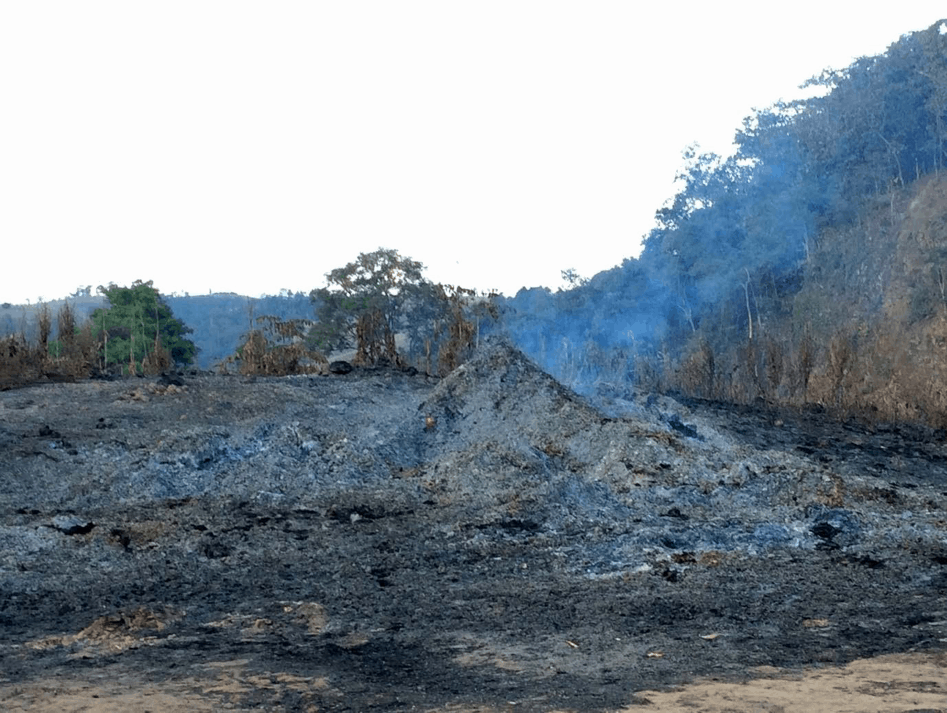
As you can imagine, each of these piles generate tremendous amounts of smoke as they slowly smolder.
And remember, this is just one pile, in one part of Mae Cham, which is just one small region in Thailand. Multiply this by hundreds, and you start to see the scale of the problem.
Then zoom out even further, and remember, this is just the smoke caused by the discarded cobs and husk (15% of the plant). The corn stalks make up 4x as much waste as this, and share the same fate.
Without access to expensive tractors or heavy machinery, farmers have no way to clear the stalks (63% of the corn crop) from their fields. Besides, much of this corn is grown on slopes that are far too rocky and steep for tractors. To make matters worse, the microbes required to decompose hard corn stalk demand so much nitrogen that they may actually deplete the soil of this precious nutrient.
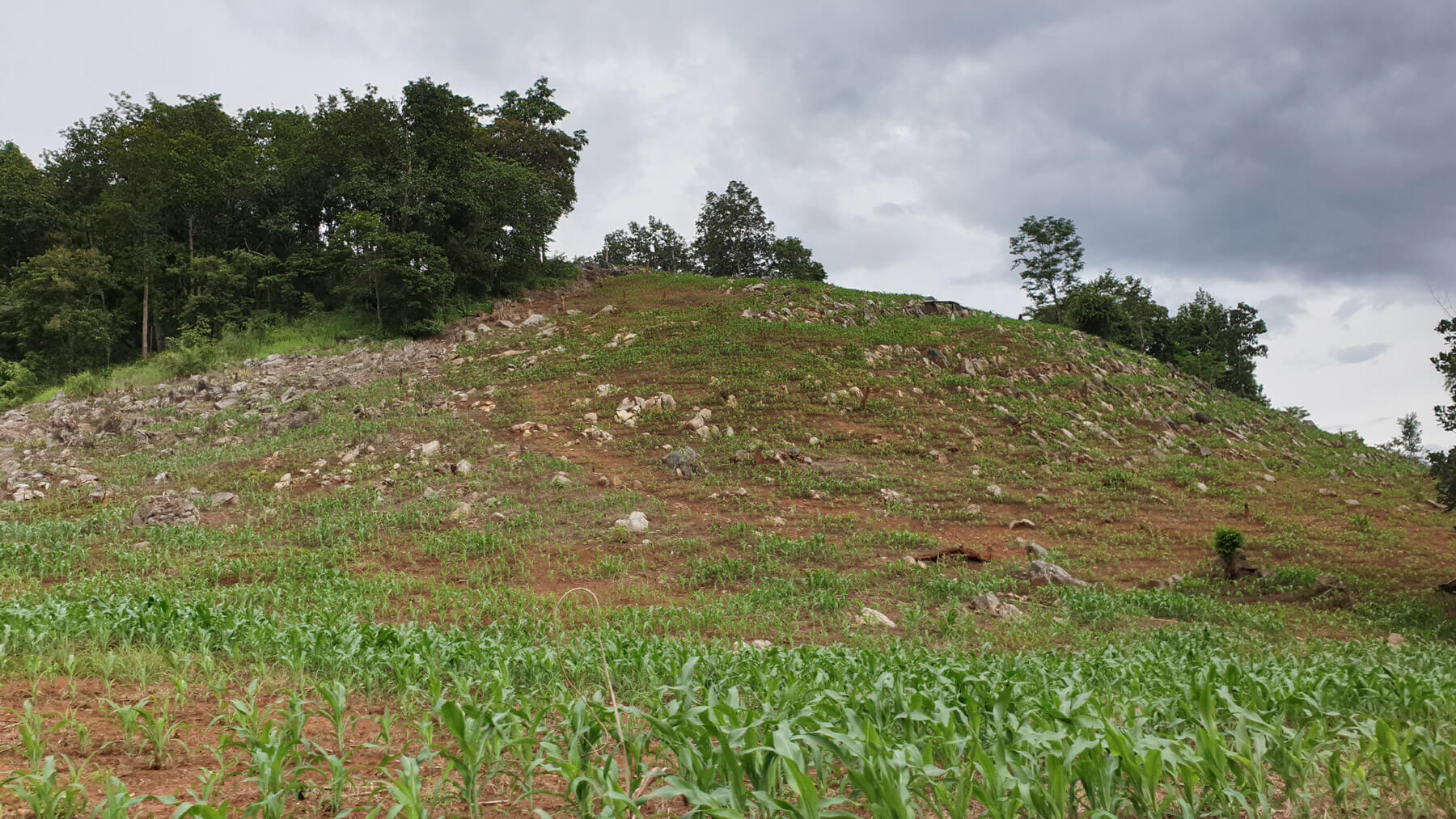
While a number of “burning bans” have been announced over the last few years, these have been largely ineffective. In fact, they have just made the burning season start earlier as farmers now burn in December and even November rather than waiting.
Technically, open burning is already illegal in many places, but the unfortunate reality is that enforcement is a difficult matter in remote villages. These are small, tight-knit communities, entirely dependent on income from farming, and efforts to enforce bans are met with resistance or entirely ignored.
However, it would also be a mistake to pin the blame solely on the farmers.
It’s important to remember that most farmers burn because they have no other choice. They are amongst the poorest demographic in the country, with 40% of farming households living below the Thai poverty line, according to a 2018 survey by the Bank of Thailand. Farm income averaged just 57,032 baht per household in 2017, that’s just ~$5 per day to support an entire family. To put this in local perspective, the national average family size is 2.7 persons. If $5 per day is divided by 2.7 people, per person, daily income is $1.85 or 50% of the Thai national poverty line of $3.60 per day.
They can’t afford tractors. The meager income they earn from farming is barely enough to make ends meet. Clearing fields by hand would take weeks of work in brutal heat (43⁰ C/105⁰ F) without pay – and without anything to do with the waste once collected.
What is a poor farmer’s best alternative? Fire. It is cheap, fast, thorough – and largely effortless.

The Warm Heart biochar program takes a new approach.
Rather than demanding that farmers stop burning, we ask: “What if we gave them an incentive not to burn?
What if farmers could actually make money from not burning their crop waste?
Suddenly, the equation changes.
Rather than being a burden and a cost, crop waste would become an opportunity for income. Farmers wouldn’t want to burn their crop waste. Burning would not only be needless, it would be money up in smoke! Such a simple trade-off: trash for cash.
It’s a “2-for-1” win-win opportunity. Stop the smoke crisis and help raise rural agricultural households out of poverty.
“How can crop waste be turned into a useful product with economic value?”
At Warm Heart, we spent a long time exploring this problem.
To make a difference, any solution must be simple enough to to spread quickly across the country. It must be a model that farmers and village cooperatives can easily replicate themselves, without need for intervention from an outside group or charity.
A successful solution must:
We found a solution that ticks every box.
It’s simple, elegant, highly effective, and goes by the name of biochar.
Biochar is “super charcoal” made by heating biomass (for example, crop waste) without oxygen, in a process called pyrolysis. It has many wonderful properties, and can be used to improve soils, purify contaminated air and water, improve animal health, and even fight climate change.
Though it’s still unknown in many parts of the world, humans have been using biochar for centuries. It’s use dates back to at least 450 BCE, when ancient Amazonian civilizations began using it to enrich their soils, creating extremely fertile layers of earth now known as “terra preta”.
Making biochar is simple and requires only basic equipment that farmers can easily DIY from inexpensive materials they have readily available.
And best of all – making biochar creates no smoke!
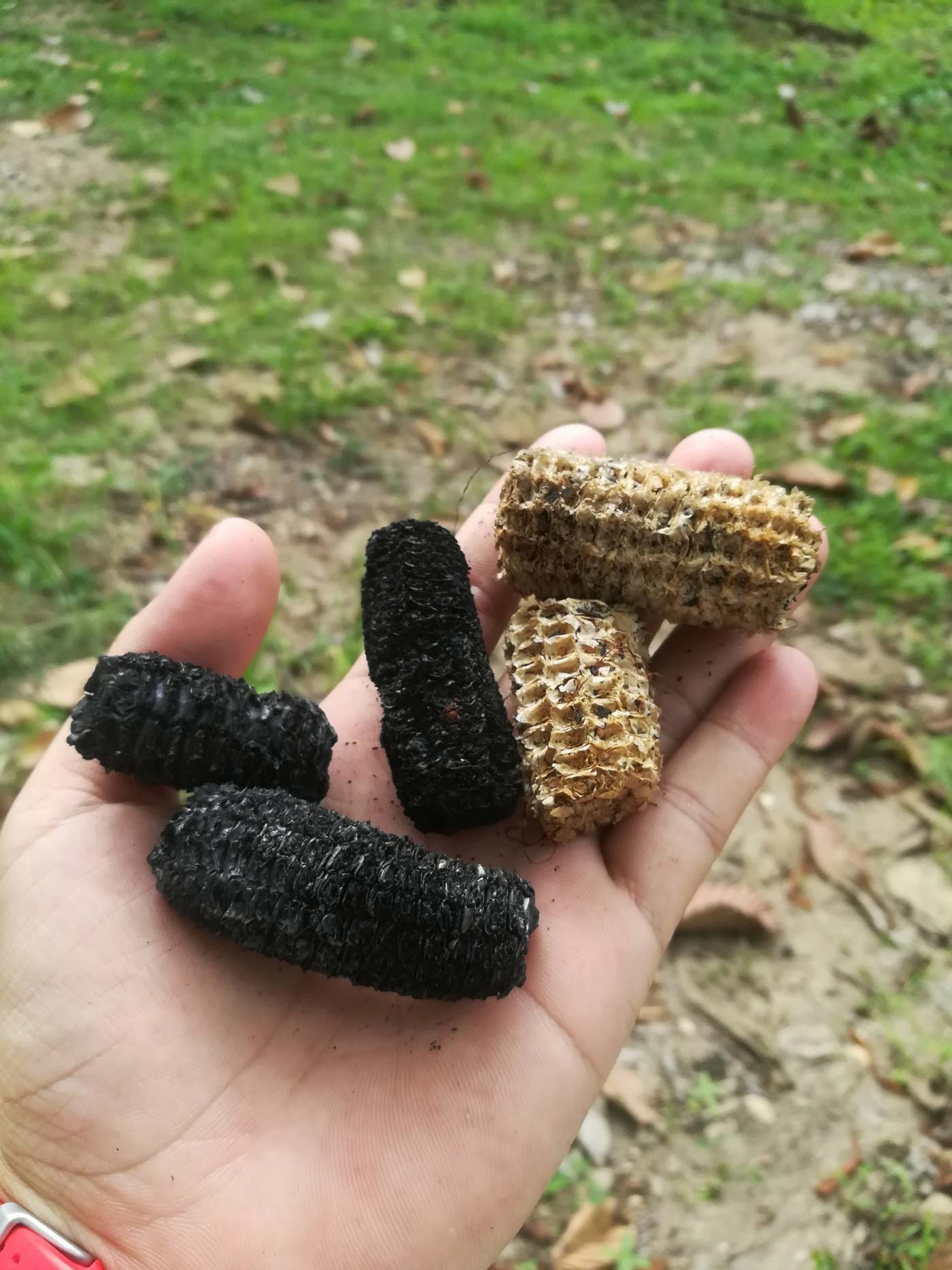
Rather than burning their crop waste on the field, investing in very simple equipment allows farmers to turn it into biochar.
Not only does this eliminate the smoke (PM2.5), it also leaves farmers with a valuable material that could improve crop yields and earn them extra income (more on this in a minute).
Biochar can be made easily using a low-cost kiln called a TLUD (“Top-Lit Updraft” gasifier). A TLUD is nothing but a modified oil barrel with holes at the bottom and a chimney on top. Here is a whole collection of TLUDs – all lit and making biochar (do you see any smoke?):
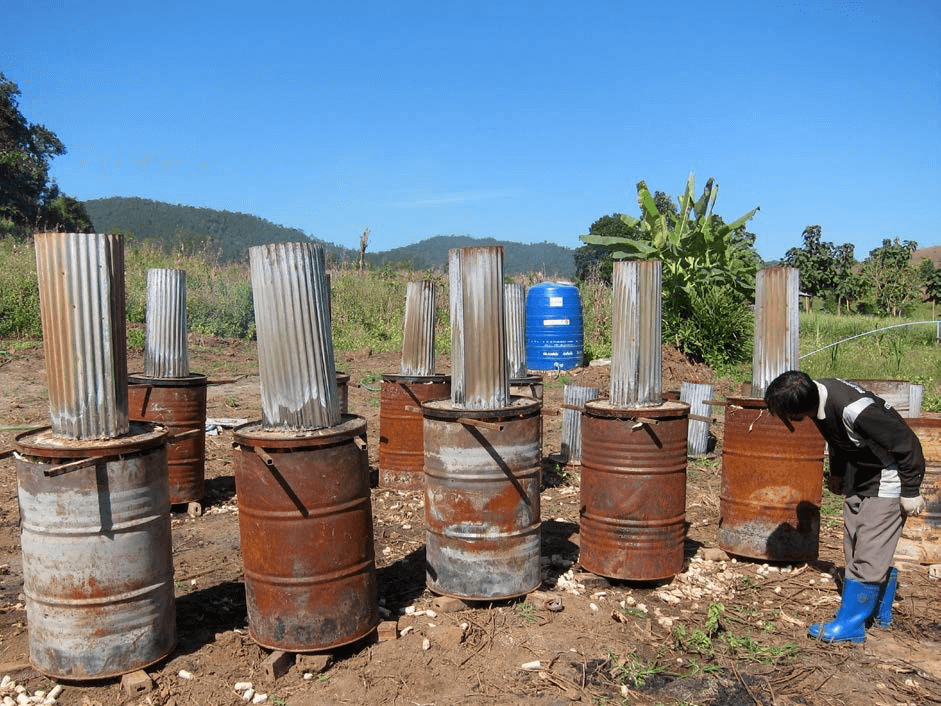
These kilns are filled with dry biomass, and then lit from the top. The design of the kiln creates a low-oxygen environment that releases no smoke and no GHGs as the biomass burns.
After a few hours, everything in the biomass that isn’t carbon will have gassified and burnt away. The fire is extinguished at this point, leaving pure carbon biochar. Once it’s cooled down, you can tip out the biochar and load up the TLUD for another round!
The biochar represents 50% of the carbon removed from the atmosphere through photosynthesis by the biomass. If returned to the soil, this biochar sequesters CO₂, helping to cool the planet!
Viewed under a microscope, biochar resembles a sponge.
Its surface consists of millions upon millions of tiny holes or pores. This vast network of pores creates a huge amount of surface area. In fact, just a teaspoon of biochar can have the surface area of a football field!
The surface of biochar is also electrically charged. This causes chemicals and elements in the soil and water around it bond to its surface. A piece of biochar right out of the TLUD is as sterile as the Sahara; stick in in the ground for a few months and it has become a mini-ball of mineral fertilizer, scaly with calcium, iron, magnesium, manganese, nitrogen, phosphorous, potassium, sulfur and zinc.
The “electrified-sponge-like” surface structure of biochar gives it its many incredible uses. Biochar:
Dramatically Improves Soil Fertility
The addition of biochar will restore damaged soils and dramatically improve soil quality, especially in poor soils found throughout the tropics (fifty percent of Thailand’s soils are classified as “Acrisols” or “Ferisols” the least fertile of all soils in the world).
Being alkaline, biochar can help to neutralize the pH level of the highly acidic soils found in Northern Thailand, increasing the ability of crops to take up nutrients from the soil. Biochar’s “sponge-like” structure also creates a protective environment for soil microbes, leading to healthy, living soil.
This may not sound like a big deal, but take a look at the difference it can make:
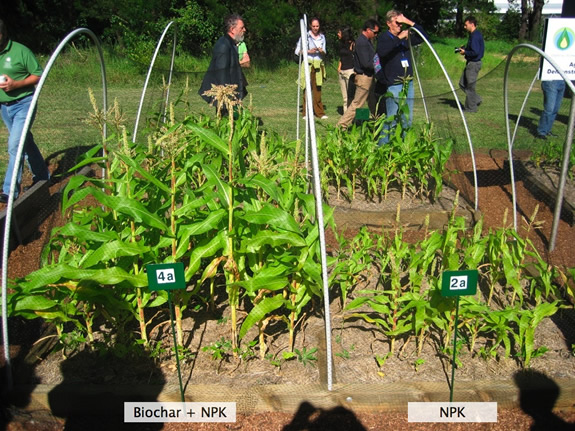
Reduces the Amount of Fertilizer and Pesticides Needed
Fertilizer and pesticide runoff is a major problem in countries all around the world
When it rains, these chemicals tend to leave with the runoff or leach from the soil. The common estimate is that 50% of agricultural chemicals get washed away before doing their job. This means that farmers must pay for twice as much as their crops need – and creates environmental catastrophes in rivers, lakes, and oceans.
Biochar can solve this problem. It has a negative electric charge that causes fertilizers and pesticides to stick to it, “anchoring” them in place so they can’t be washed away.
Holds Water and Keeps Soil Moist
Like a sponge, biochar can hold a lot of water in its pores. When ground up and mixed into soil it will keep the earth moist for longer, making it more resistant to droughts. It also means farmers need to water their crops less frequently.
Filters Air and Water
Biochar is highly effective at filtering air and waterborne pollutants. Running water through biochar is one of the easiest, lowest-cost methods to purify water polluted with heavy metals or agricultural or industrial chemicals.
Improves Animal Health When Added to Feed
A growing body of research is demonstrating biochar’s ability to improve animal health when added in small amounts to poultry-, pig-, cow-, or even fish- feed. Its porous surface is thought to improve gut health.
Powerful Solution for Climate Change
Making biochar won’t just benefit Thai farmers. It will benefit Thailand and the world. That’s because biochar is a powerful tool for fighting climate change.
When a plant grows, it removes carbon from the atmosphere. Eventually, however, the plant dies, and all this carbon is released back into the atmosphere again as the plant decomposes. This makes growing plants “carbon neutral” because carbon goes in and the same carbon comes back out, nothing lost, nothing gained.
When you pyrolyze crop waste and turn it into biochar, you are preventing it from decomposing, and locking up to 50% of its carbon into a very stable form that it can’t return to the atmosphere. If you make a kilogram of biochar, you have pulled that carbon out of the atmosphere. If you put that biochar in the ground, you have stored it securely for thousands of years.
Making biochar is, therefore, “carbon negative” – meaning that you are actually removing carbon from the atmosphere. The more biochar you make, the more CO₂ you remove from the atmosphere and the more you contribute to cooling the climate. In fact, biochar has been identified by Project Drawdown as one of the 100 most important solutions we know of for fighting climate change.4
For starters, most farmers simply haven’t heard of it.
For the last few years, Warm Heart has been working on educating farmers in the district of Mae Chaem about biochar’s uses and potential for stopping the smoke crisis. For more details, see this article.

Warm Heart first had to overcome the skepticism of many who did not believe that farmers would stop burning.
In our first initial experiments, however, we proved that given even a small financial incentive farmers will happily not burn and take the time to turn their crop waste into biochar. This stopped the smoke before it happened, eliminating the PM2.5 pollution that would otherwise have plagued everyone.
The farmers we worked with in Mae Na Chon, Mae Chaem happily made biochar when paid to do so.
Without a financial incentive, however, they have been reluctant to make it for use on their own fields.
They argued that they require little biochar compared to the amount of crop waste produced every year, and would stop making it once they had enough for their own farms. This would leave most of the biomass to be burned as before. Farmers, they observed, had other things to do and would not make biochar for no reason at the expense of completing other tasks.
After the encouraging results we have seen in Mae Chaem, our efforts are now focused on kickstarting a demand for biochar in Thailand.
This involves a lot of education, as most people have not yet heard of this wonderful material. Crucially, this also means demonstrating that making products from biochar can be economically viable.
What is needed is a business model that offers farmers and villagers a real incentive to turn their crop waste into biochar, rather than burning it.
We are working on a number of pilot projects, including:
1. Biochar Fertilizer
We are exploring how farmers or villagers could band together to create a profitable fertilizer business. Early data suggests that despite subsidies for synthetic fertilizers, biochar soil amendments can be priced competitively. If farmers worked together at a village cooperative level, they could produce their own fertilizers. They could save money by not buying synthetics, and sell any excess for a profit.
2. Biochar Briquettes
Millions of households across Northern Thailand still burn firewood, lump charcoal or charcoal briquettes as their main source of energy for cooking. These energy sources all require the unsustainable cutting of forests (i.e., deforestation). When burned, they also smoke terribly and create a major health hazard. Briquettes, however, can be made from biochar. Being nearly pure carbon, they do not smoke or smell. They light faster, and burn hotter and longer than traditional charcoal.
3. Our Agroforestry Program
New to our list of programs in 2021 is our recently announced Agroforestry Program, which aims to help farmers move away from their dependence on growing corn to more sustainable methods of farming. Though corn will grow under almost any conditions, most other trees and high-value crops won’t. Encouraging farmers to move to agroforestry thus not only cuts down on the amount of corn crop-waste created each year, it also creates demand for more biochar to enrich soils enough to grow more valuable crops. See this page for more information on this program.
The goal of these projects is to demonstrate that there is money to be made from biochar.
They are simple solutions that don’t require high investment costs, and can be easily imitated.
Once farmers see that it is possible, these solutions could very quickly spread from village to village. First very slowly, then all at once.
It’s hard to overstate how much of a difference this can make.
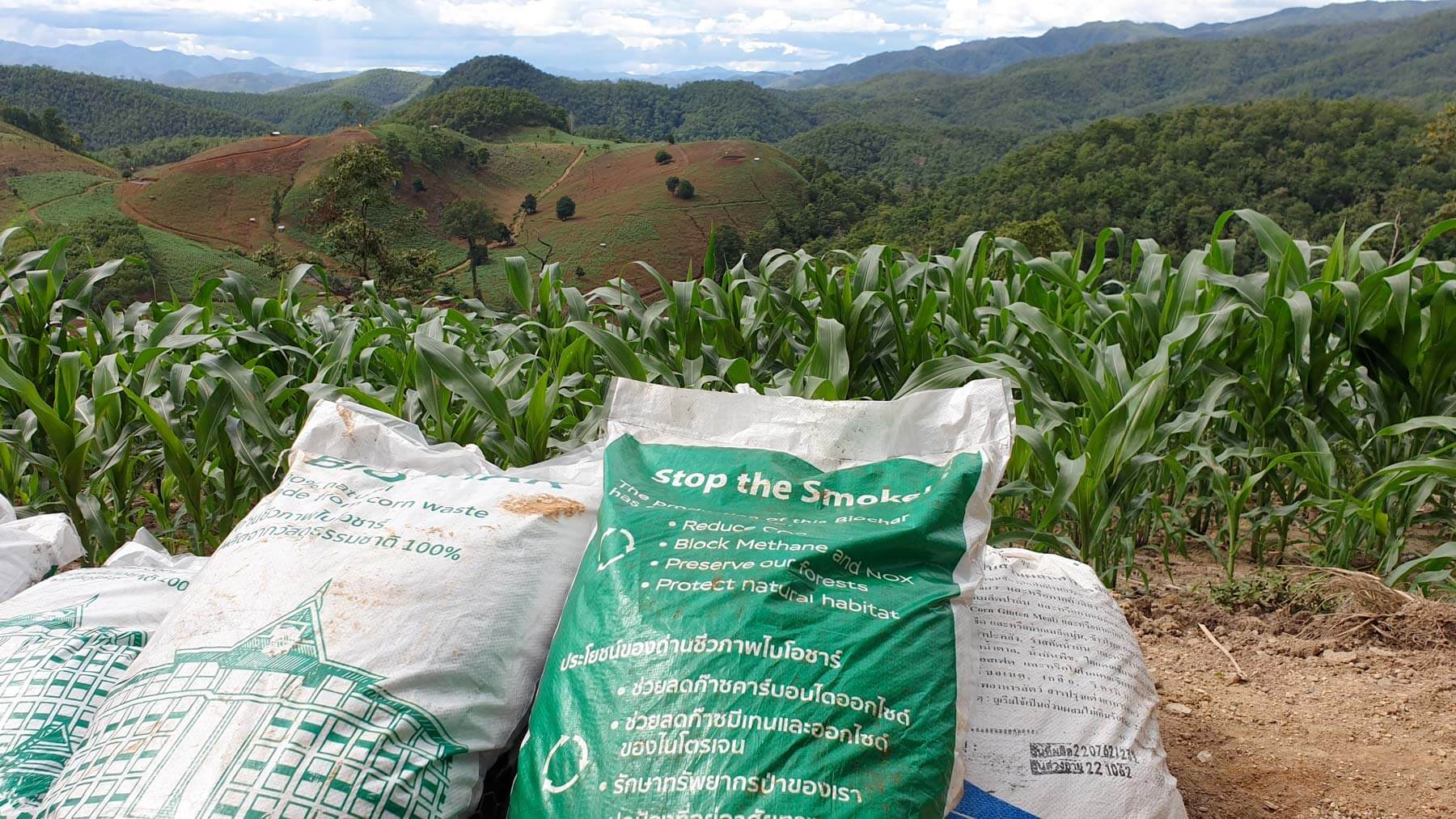
Rather than burning their waste, farmers can put it to use. Rather than smoke and haze, we could see blue skies year-round again.
We can help some of the poorest households in Thailand lift themselves out of poverty. We could make a meaningful impact on climate change, as CO₂ is removed from the atmosphere and locked into the soil. One step at a time, we can end this smoke crisis.
Help us as we bring biochar to Thailand, and stop the burning problem one farm at a time!
Burning season is upon us, and we are in urgent need of funds to prevent as much smoke as we can!
No matter how old you are, where you live, or what you can give, you can help end the smoke crisis—and you can start right now!
Please make a difference by contributing today:
Stop the Smoke is an initiative by Warm Heart, a grassroots organization that helps Thai villagers in the remote northern district of Phrao, Chiang Mai Province.
We organize community projects that provide access to improved education and basic health services, create jobs and sustainable incomes for the poorest in our community, and restore the environment so it will sustain future generations.





Copyright © 2021 Warm Heart Worldwide | Registered 501(c)(3). EIN: 26-2059241